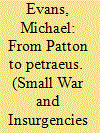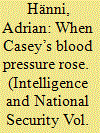| Srl | Item |
| 1 |
ID:
131471


|
|
|
|
|
| Publication |
2014.
|
| Summary/Abstract |
War is the great auditor of military institutions and since the attacks of 9/11, the United States military has been under audit for well over a decade - the longest period of continuous warfare in its entire history - and one in which strategic success seems at best, ambiguous and at worst, elusive. Not surprisingly, the strategic skill and battlefield effectiveness of the American military has been a subject of great inquiry over the last five years. Thomas E. Ricks's mammoth study, The Generals: American Military Command from World War II to Today is but the largest instalment in a plethora of works examining America's military performance in the modern era by such writers as David Cloud and Greg Jaffe, Stephen R. Taaffe, Lewis Sorley, Jean Edward Smith, and Fred Kaplan.1
|
|
|
|
|
|
|
|
|
|
|
|
|
|
|
|
| 2 |
ID:
083034


|
|
|
|
|
| Publication |
2008.
|
| Summary/Abstract |
The US military went into Iraq with no clear understanding of or preparations for counterinsurgency. This fact, combined with poor postwar planning and failure to recognize the early development of the insurgency, severely hamstrung the American effort to secure and stabilize the country. Nevertheless, the US Army demonstrated the ability to adapt effectively from the bottom-up at the operational and tactical levels during General George Casey's tenure as commander of Multinational Force-Iraq from 2004 to 2006. Yet despite the success of population-security measures and the development of counterinsurgency doctrine, the military's top leaders in Iraq resisted the implementation of a true population-centric counterinsurgency strategy, opting instead to focus on a 'transition' exit strategy. It was not until after the transition approach collapsed amid the chaos of 2006 that counterinsurgency, and the utility of force in securing the will of the population, was embraced by America's strategic leadership
|
|
|
|
|
|
|
|
|
|
|
|
|
|
|
|
| 3 |
ID:
149295


|
|
|
|
|
| Summary/Abstract |
This article contributes to the debate on the politicization of intelligence with a case study of a major attempt of politicization that so far largely escaped academic attention: the Special National Intelligence Estimate on the Soviet Union’s role in international terrorism produced by the US Intelligence Community in spring 1981. Despite direct and indirect manipulation by members of President Reagan’s Cabinet, this case differs from those usually discussed in a decisive way – politicization failed. Based on the empirical analysis, a theoretical model of intelligence politicization is introduced that extends Joshua Rovner’s oversell model, which can explain why policymakers demand intelligence support but is insufficient due to its exclusive focus on the consumers of intelligence, by integrating the incentives of intelligence producers and specifying the determinants of whether politicization succeeds or fails.
|
|
|
|
|
|
|
|
|
|
|
|
|
|
|
|